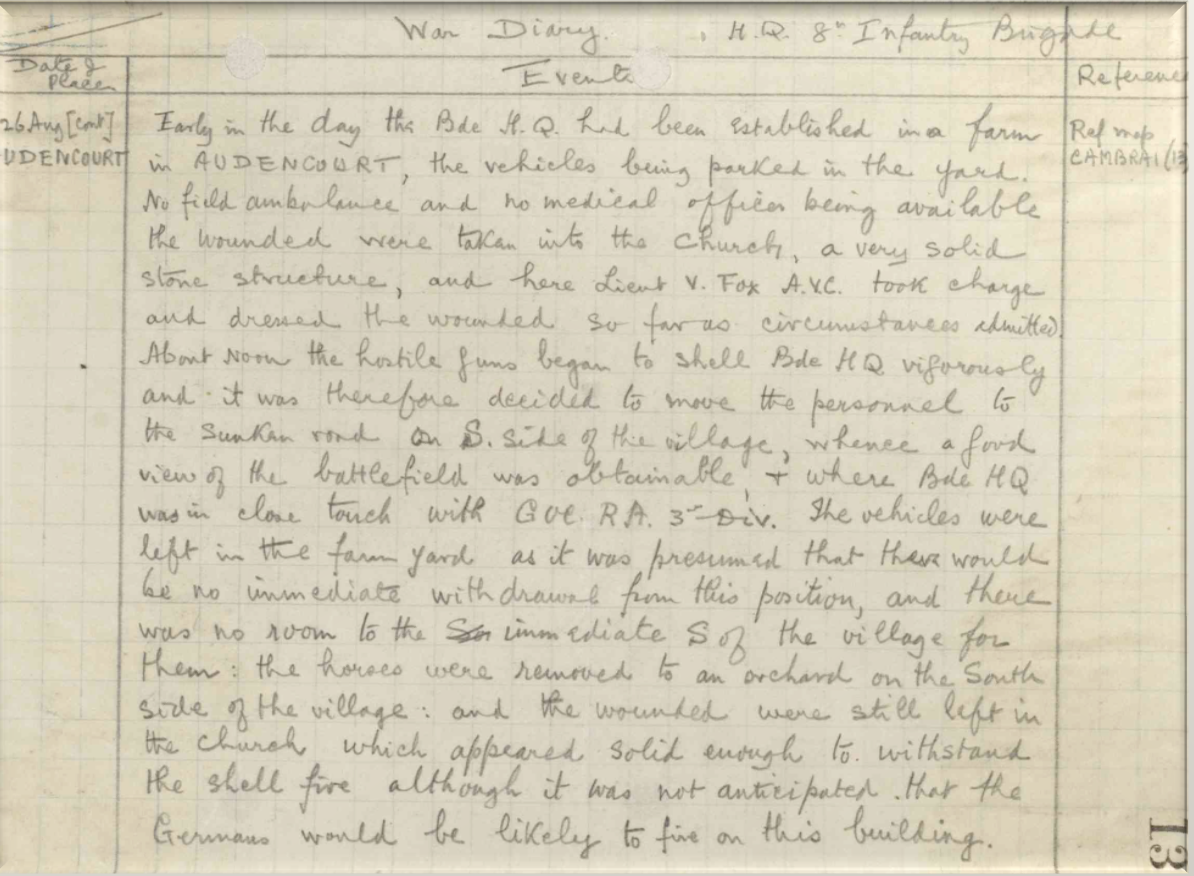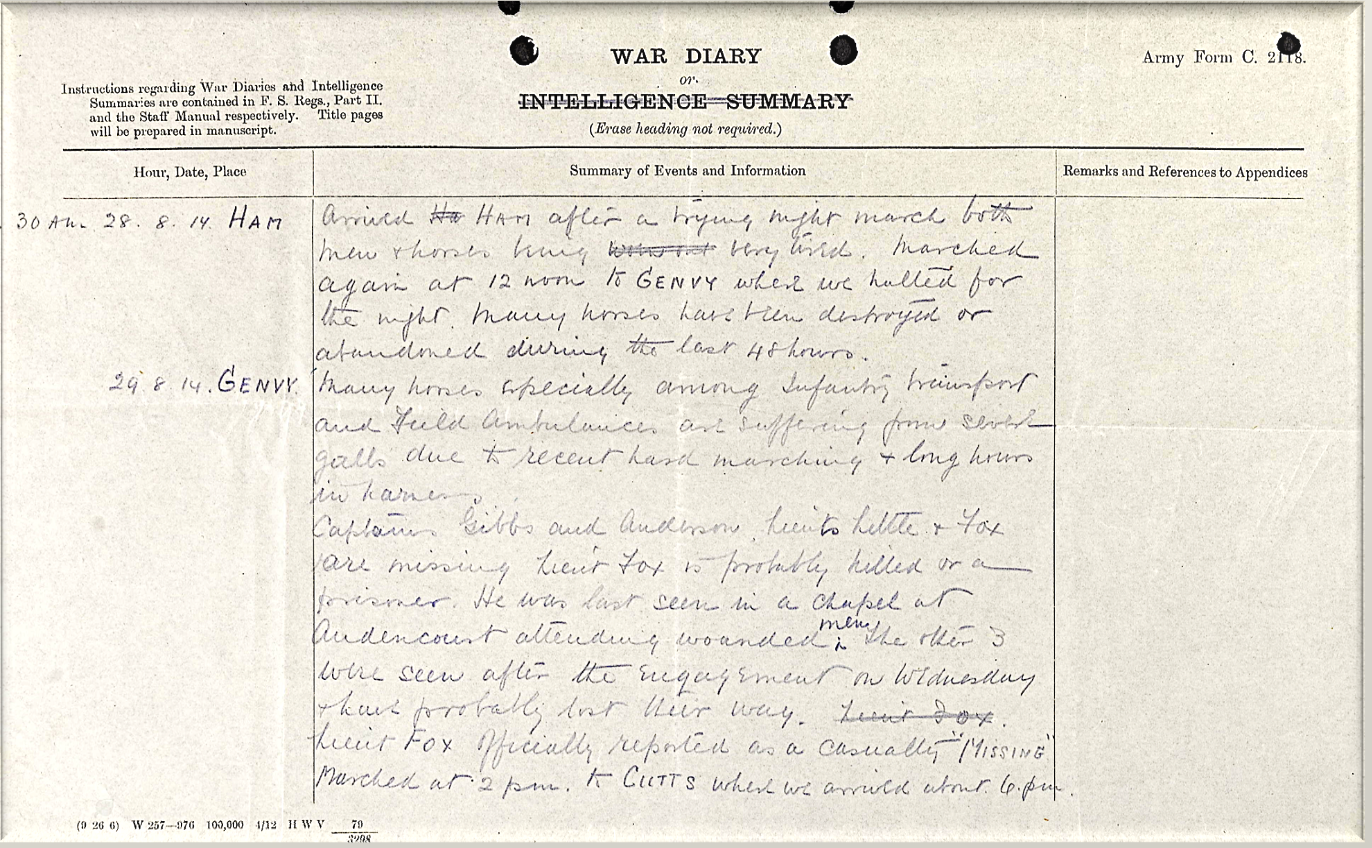FOX, Vincent
Personal Details
| Attribute | Details |
|---|---|
| Nationality | British |
| Date of Birth | 1889 |
| Place of Birth | Hacksballscross, Carrickastuck, , Louth, Ireland |
| Veterinary College and Date of Graduation | Dublin - December 1911 |
Military Service
| Attribute | Details |
|---|---|
| Last Rank | Lieutenant |
| Regiment/Service | Army Veterinary Corps |
| Secondary Regiment | 8th Infantry Brigade |
| Secondary Unit | |
| First Theatre of War | France 17 August 1914 |
Casualty Details
| Attribute | Details |
|---|---|
| Date of Death | 26 August 1914 |
| Age at Death | 25 |
| Place of Death | Audencourt, France |
| Cause of Death | Killed in action |
Cemetery
| Attribute | Details |
|---|---|
| Cemetery | Caudry British Cemetery |
| Location | Caudry, Francem |
| Grave Reference | III.C.1 |
| Commonwealth War Grave | Yes - GWGC Headstone |
| Emblem or Badge on Headstone | Army Veterinary Corps |
Honours and Memorials
| Attribute | Details |
|---|---|
| Name on RCVS Honour Board | Yes |
| Name In Officers who died in Great War | Yes |
| Medals and Awards |
|
Biography
Lieutenant Vincent Richard James Fox MRCVS was born at Hacksballscross, Carrickastuck, County Louth, Ireland. The youngest of 10 children, his father died in 1890 and his mother in 1908. The 1911 census shows the family, headed by the eldest son, Patrick, living at 25 Quay Street, Dundalk.
Fox entered the Royal Veterinary College in Ireland in 1907 and graduated MRCVS in December 1911. He initially worked in Dundalk, and then in May 1912, he sailed to Calcutta. Here, he worked for RS Hart Bros, described as a ‘Royal Horse Repository and Veterinary Infirmary’ by its owner, Robert Spooner-Hart MRCVS. The work varied, ranging from veterinary surgery to horse breeding and dealing; the company also consulted veterinary surgeons to the Calcutta Turf Club. Spooner-Hart died in March 1914, and about that time, Fox returned to Ireland, keen to pursue a military career.
Fox received his commission, in the rank of Lieutenant, on probation, in the Army Veterinary Corps on 31 July 1914.
Fox was one of the first veterinary surgeons to depart for France. Serving as Brigade Veterinary Officer to 8 Infantry Brigade, he arrived in Boulogne on 14 August. The Brigade were deployed north into Belgium and, by 22 August, were at Mons, facing the advancing German army. The position of the British troops meant there was a real risk of their being cut off, and on 22 August, the order was given to retreat. By 25 August, 8 Brigade were positioned in the town of Audencourt, to the east of Le Cateau.
Here, the commanding officer deployed the bulk of his troops around Le Cateau to provide support for the men of I Corps as they retreated on his eastern flank. He was ‘advised’ to withdraw but informed the Commander in Chief that he was unable to move any men and that he had decided to stand and fight.
The Battle of Le Cateau took place on Wednesday, 26 August. The headquarters of the 8 Brigade were initially sited in a farm in Audencourt. The Brigade diary reported that:
At about noon the brigade came under a sustained artillery barrage and it was decided to move south. The horses were taken to a nearby orchard; the wounded, being treated by Fox, were to be left in the church, since it was considered strong enough to withstand shell fire. At 2.30pm the Germans commenced a bombardment of Audencourt, with disastrous consequences. Shelling of the orchard led to the death of all the horses and in the late afternoon the church was hit. Witnesses described how the spire was struck, followed by an explosion and the building caught fire. At least one high explosive shell entered the building, causing substantial damage and destruction, resulting in the death of Lieutenant Fox. His family were later to receive reports that his dead body was found, ‘without a mark or scar on it’.No field ambulance and no medical officers being available,the wounded were taken into the church, a very solid stone structureand here Lieut V Fox ARMY VETERINARY CORP took charge and dressed the wounded.
Fox was buried in the Commonwealth War Grave Cemetery at Caudry British Cemetery.
His death is reported in the in Veterinary Record on October 3, 1914.
Links
Media and Documents


